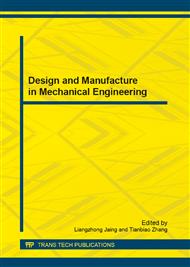p.78
p.82
p.86
p.92
p.98
p.104
p.109
p.117
p.122
Forming Process and Mechanical Properties of Fiber Reinforced Polymer Concrete for Elementary Machine Parts
Abstract:
For the good vibration alleviating properties, polymer concrete (PC) has attracted much attention in the field of elementary machine components. In order to get more excellent mechanical properties, the forming process and mechanical properties of PC were concerned. In this research, glass fiber and carbon fiber were applied to improve the mechanical properties of PC. A series of PC and fiber reinforced polymer conctete (FRPC) specimens were prepared basing on the orthogonal tables for property test. Compression strength test was carried out. It is obvious that FRPC is better than PC as far as compression strength is concerned, and carbon fiber reinforced polymer concrete (CFRPC) is better than glass fiber reinforced polymer concrete (GFRPC). Trend curves about the relationship between fiber length and compression strength, as well as that between fiber dosage and compression strength were drawn. Relationship between the considered factors and compression strength is analyzed basing on the experiment results and the trend curves. Strengthening fibers would bear most of the internal stress when the specimen is faced to outer loads. Thus, FRPC has much better properties than PC. Mechanical properties of CFRPC are relatively better than that of GFRPC, for the strength of carbon fiber is better than that of glass fiber. It could be concluded that glass fiber is the proper strengthening fiber for PC considering both technical and economical factors.
Info:
Periodical:
Pages:
98-103
Citation:
Online since:
September 2013
Authors:
Price:
Сopyright:
© 2013 Trans Tech Publications Ltd. All Rights Reserved
Share:
Citation:


